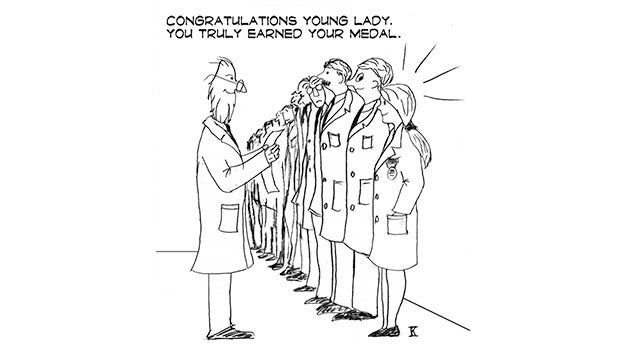Dr. Witherspoon: Narrow Passage
Published 2:56 pm Thursday, February 29, 2024
|
Getting your Trinity Audio player ready...
|
A woman with painful arthritis decided to undergo knee replacement surgery in a small-town hospital. Her family doctor performed a pre-operative evaluation and cleared her for surgery. Her surgeon did a history and physical examination.
The patient arrived at the hospital on the assigned date. As instructed, she had eaten nothing after midnight the night before. They took her to the pre-operative holding area, put her in a gown, and started an i.v.
The anesthesiologist assigned to the case had recently completed training, brand new to the practice, and came in to speak with her. She needed a few moments to assess the patient before taking her back to the operating room. While listening to the patient’s chest with her stethoscope she detected a prominent murmur, an abnormal heart sound that can portend a diseased valve.
Did the patient have an echocardiogram, the test that evaluates heart valves? The patient knew nothing about that. The anesthesiologist asked the surgeon, and he didn’t know either. There wasn’t one in the chart. She called the patient’s family doctor and received the same response. It seems nobody had ever done an “echo” on her, despite the obvious murmur.
“We really need to do that,” she said. It would delay the surgery an hour or so, but the anesthesiologist insisted. The surgeon gave no argument.
The test revealed her aortic valve diameter was .71 cm, considered critically stenosed. They consulted a cardiologist who was very concerned. Joint replacement surgery was out of the question. The patient needed a new aortic valve. The cardiologist called a major hospital that had a heart center and arranged her transfer.
Still in her hospital gown with i.v. line in place, the patient was put in an ambulance, taken on an hour-long ride to the big hospital where she underwent aortic valve replacement surgery. The nurses in the holding area at the heart center were surprised to have an unscheduled cardiac case arrive by ambulance, npo, i.v. in place and running, gowned up, and ready to go back to the OR.
“Wish they all came like this,” one of the nurses in the holding area said.
She signed a consent and the cardiothoracic surgeon replaced her valve.
The knee would have to wait.
DR. WITHERSPOON SAYS:
Good night! She went from a knee to a heart all in one morning. Must have been a busy (and confusing) day for this understanding lady. I admire her patience.
Score one for the anesthesiologist. Puttin’ the breaks on this operation may have saved the patient’s life.
As we all know, the aortic valve is subject to its own form of arthritis, like knees, hips, etc., only when it becomes stiff and calcified, the outflow orifice can become dangerously narrowed.
When a person is put under anesthesia blood vessels dilate, which increases volume and reduces blood pressure. To maintain blood pressure, additional fluid is given through the i.v. This can be quite a bit, especially if it’s a long case or involves significant blood loss.
To get through this ordeal, the heart must be able to mobilize more fluid than is typical for its daily routine. It must have some reserve capacity, not only during the operation, but in the days following, when the body is mobilizing all that third-spaced fluid accumulated during surgery.
This patient’s aortic valve was so narrow, the left ventricle may not have been able to pump more blood through its tiny outflow orifice, no matter how hard it tried. It had little, if any, reserve capacity. All that fluid would’ve backed up in her lungs causing congestive heart failure. It would have been a very dangerous two or three days, the classic scenario where a patient can a crash out of nowhere at 3:00 AM.
Good save! The anesthesiologist in this one deserves a hearty “well done.”
Now then. Does anybody do a blasted physical examination anymore these days?! Her family doctor cleared her for surgery. Did he ever listen to her chest? When you do a dad-gummed physical examination, examine the patient! The orthopedic surgeon missed it, too but, I must say, we orthopods ain’t exactly the best chest listeners out there (ahem). Still, no excuses.
A lot of surgeons would have pitched a fit about anesthesia delaying a case just to get an echocardiogram. Surgeons need to read about this one and understand the risk they take when they give the anesthesiologist a load o’ grief for wanting to look into something.
Swallow your pride and do what’s in your patient’s best interest. Safety first! That’s paramount. Nobody evaluates pre-op patients more thoroughly than anesthesiologists because they are the last gateway to the operating room. When they pass that last examination, the die is cast. If a critical finding in the labs, studies, or clinical examination is missed, the next step may be a critical event in the OR while surgery is underway, and you do not want to go through that.
Your ol’ doc’s mighty proud of this young doctor. When she heard that murmur, her radar homed right in on it. No way was she gonna let this one get by her.
Just goes to show, regardless of the million-dollar electronic gizmos modern medicine has, you can still save a life with an ordinary stethoscope (providing you have the right pair of ears attached to it). If medicine handed out medals, this doctor would certainly qualify.
Congratulations to you, young lady. High marks and, again, good save.
(She went on to become Chief of Anesthesia at a level-two trauma center and a distinguished career.)
J. M. MACDAVID M.D. also known locally as Dr. John Kona can be contacted at WitherspoonInstitute23@gmail.com.



